
St Peter’s Catholic Church, Toorak: exterior
[photograph by John Maidment (9 February 2021)]
Historical and Technical Documentation by John Maidment
© OHTA, 2021 (last updated February 2021)

St Peter’s Catholic Church, Toorak: exterior
[photograph by John Maidment (9 February 2021)]
The Catholic parish of Toorak was established on part of the Toorak House estate when it was subdivided in 1901. A new brick church dedicated to St Stanislaus (patron saint of Poland) was blessed and opened on 11 February 1912. The building was designed in a Romanesque style by architects Kempson & Connolly.1 The foundation stone of the present church was laid on 17 December 1933. The architect was O.H. Jorgensen.2 Only part of the nave and the sanctuary together with a large sacristy (used for mixed marriages) were erected initially and the former church was used as a temporary nave. The building was dedicated to St Peter. Stained glass windows by Mathieson & Gibson and Brooks, Robinson were installed at the time.3 The masonry baldachino placed behind the high altar is a focal point of the interior. In 1965, the remainder of the nave and tower base were erected to a simplified design. Major renovations to the building were completed in 2020 including a glass lantern to the tower, a large new rear window made by Geoffrey Wallace, and the addition of a side chapel to the left of the sanctuary, all under the supervision of Andronas Conservation Architecture. Electrically-operated bells were placed in the tower.

St Peter’s Catholic Church, Toorak: case of Bevington & Sons organ when at St Francis’ Church, Melbourne
[photograph by C.J. Frazer – courtesy of Blessed Sacrament Congregation and St Francis’ Church Heritage Centre, Melbourne]
The organ was built by Bevington & Sons, Soho, London and was acquired by Bishop James Goold for St Francis Cathedral, Melbourne during his overseas sojourn from April 1851 to March 1853.4 It has been claimed that it was exhibited by Bevington at the 1851 London exhibition,5 but it was never listed among the exhibits so the claim appears to be spurious.6 It could be that it may have been intended to be exhibited, but was incomplete at the time. The case of the organ was very elaborately carved and it is not impossible that the famous architect A.W.N. Pugin, who had an association with Bevington,7 may have designed it.
The specification of the Bevington organ was:
| GREAT Bourdon Teneroon Open Diapason Stop Diapason Clarabella Keraulophon Dulciana Principal Flute Twelfth Fifteenth Sesquialtra Mixture Trombone Trumpet Cremona Clarion Swell to Great |
16 16 8 8 8 8 8 4 4 2-2/3 2 4 rks 2 rks [16?] 8 8 4 |
CC-BB? TC? |
|
| SWELL Double Diapason Open Diapason Stop Diapason Principal Flute Doublette Cornopean Hautboy |
16 8 8 4 4 2 rks 8 8 |
(from Tenor C) |
|
| PEDAL [Open Diapason] [Bourdon] Great to Pedal Swell to Pedal |
[16] [16] |
The instrument is from the manufactory of Messrs. Bevington, London, and has been erected by Mr. H. Smith, organ-builder, of this city.8 It has been greatly admired by all who have heard it, and reflects the highest credit on Mr. Smith for the manner in which he has erected the instrument. The compass of the great organ is from CC flat to F in alt, with two octaves of pedals, from CCC to CC flat. Compass of swell organ from tenor C to F in alt. The great organ contains the following stops: Bourdon, tenoroon, open diapason, stop diapason, claribell, dulciana, flute, keraulophon, twelfth, fifteenth, sesquialtra, four ranks mixture, two ranks, cremona, trumpet, trombone, and clarion. The swell organ contains double diapason, open diapason, stop diapason, principal, flute, doublette, two ranks, cornopean, and hautboy. It has also three couplers and four composition pedals. The organ stands 24 feet high, 13 feet wide, and 10 feet deep.9
In 1858, it was reported:
GRAND CONCERT AT ST FRANCIS’S.
Yesterday evening the Church of St. Francis’s in Elizabeth-street, was filled in every part by a large and attentive audience, who had assembled to listen to a grand concert of sacred music, given to inaugurate the re-opening of the organ, after undergoing extensive repairs, alterations, and additions at the hands of Mr Biggs, organ builder.10
In 1868, George Fincham added a Choir Organ of eight stops and the instrument reopened on 5 April 1869. The keyboards were extended to the front of the gallery.
The fine organ at St Francis’s Church built by Bevington and Sons, Soho, London is to undergo extensive alterations, which, is expected, will render it far more suitable for the requirements of the services of the church. Amongst the improvements to be made, it is contemplated to add a choir organ, lower the whole of the pipes two feet, place the bellows outside and bring down the manuals to the front of the gallery. The specification of the complete instrument, as prepared by G. Pringle, the organist, includes a great organ with seventeen stops and 760 pipes; a swell organ, of eight stops and 336 pipes; a choir organ, of eight stops and 270 pipes; a pedal organ, of two stops and sixty pipes, and three couplers. The total number of pipes will be 1,428. Mr. Fincham, the well-known organ builder, of Richmond, was contracted for the alterations.11
In 1873, Robert Mackenzie, who had arrived in Melbourne in late 1871 to install the new organ in Melbourne Town Hall, made many changes:
The organ was built by Bevington and Son, of London. A few years since, at the suggestion of the late Mr. G. R. G. Pringle, who was then organist of the church, the key-board was removed close to the front of the choir gallery, so that the organist could lead the choir, instead of performing with his back to the vocalists, as was the case when the keyboard was close to the instrument. The necessary elongation of the trackers did not, however, result satisfactorily, and hence, the present improvements. The keyboard, which consists of three manuals, is now replaced close to the organ, and the action is altered according to the latest and most improved methods. The case of the instrument has been beautified, the front pipes elegantly decorated; some of the pipes have been placed in more favourable positions; the bellows have been strengthened, and their leverage improved.
The "great” organ and the "choir” organ were available for Sunday last. The instrument now contains forty effective stops. The keyboard is on an improved principle. The execution of the alterations has been entrusted to Messrs. Mackenzie and Co. It may be remembered that Mr. Mackenzie accompanied the Melbourne Town Hall organ to the colony, and superintended the erection of that instrument in its final position.12
ST. FRANCIS’ CHURCH
Most prominently amongst the improvements stands the organ, which is now the second best instrument of its kind in Australia. Its full and sweet tones are fully brought out under the skilful and masterly touch of Signor Giorza. The organ contains 40 stops, 14 of which are new from Messrs. Hill, London; the two stops wanting to complete the 40 when first the instrument was opened are now added, namely "Geigen Principal" to great and " Principal" to choir. Through the generosity and kindness of the congregation £300 has been paid to the builders, Messrs. McKenzie and Co.13
It would appear that Mackenzie made a new and larger divided windchest for the Swell at this time as the present one has the date 1873 inscribed on one of the pallets.14
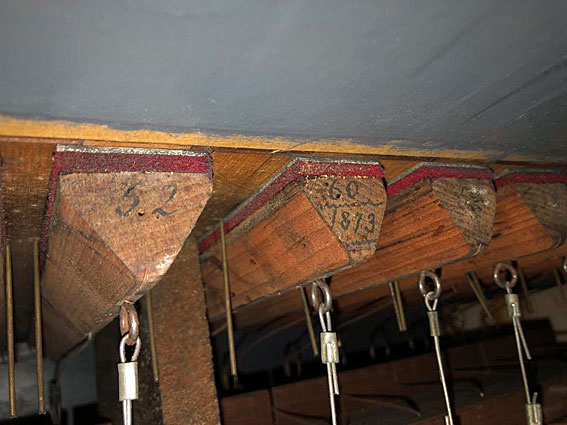
St Peter’s Catholic Church, Toorak: inscribed date on one of the swell windchest pallets
[photograph by Daniel Bittner (2020)]
In 1875, George Fincham supplied new pipes, including a Clarabella and increased the size of the bellows.15 In 1886, Fincham revoiced five stops, and in 1889 remade soundboards, recovered keyboards and carried out minor repairs. Edward Cornwall Cook took over the maintenance at a lower fee and in 1898 added metal pipes in the Double Diapason from Middle C, altered the Harmonic Flute 8 to 4ft; carried through the Great Mixture 5 ranks through all upper octaves; installed a Rohrflöte, Piccolo and Harmonic Flute on the Choir Organ in place of other stops; supplied a new pedalboard and Choir to Pedal coupler. Major repairs were carried out in 1899 by George Fincham. A hydraulic engine was installed at this time.16
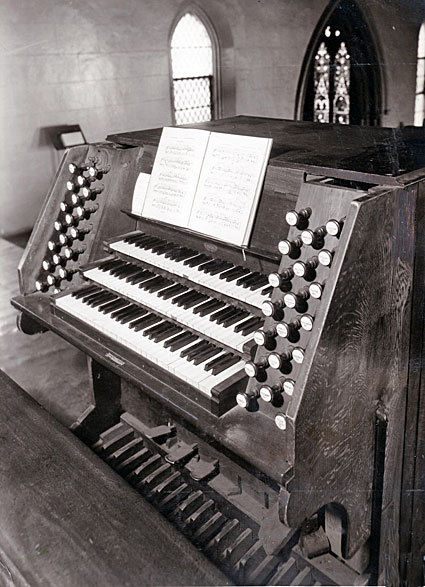
St Peter’s Catholic Church, Toorak: console of Bevington & Sons organ
when at St Francis’ Church, Melbourne
[photograph by C.J. Frazer – courtesy of Blessed Sacrament Congregation and St Francis’ Church Heritage Centre, Melbourne]17
In 1910, the organ was rebuilt and enlarged by Geo. Fincham & Son. New tubular-pneumatic action was installed but it appears that the old console was retained. The instrument was reopened on 2 October 1910.
Rebuilding of Organ.
Those who have listened with pleasure for years to the music at St. Francis’ Church will be glad to learn that the organ is to be practically rebuilt and remodelled. The Very Rev. W. Quilter has accepted the tender of Messrs. G. Fincham and Son, on whose advice the whole of the existing manual and pedal actions are to be removed and replaced by the latest system of tubular pneumatic. This will result in a light and even touch, and will not be subject to climatic influence. A new sound board will also be provided. The present pipe work, the tone of which is remarkably fine, will be retained. The cost of the improvements will be £300. This sum will secure a very fine instrument—practically a new organ with the exception of pipes and framework. Fincham says that the result of the work will be a first-class instrument, and except in the matter of tuning no further outlay will be required for many years.18
| GREAT Double Open Diapason Open Diapason Geigen Principal Stop Diapason Bass Stop Diapason Treble Salicional Principal Harmonic Flute Wald Flute Twelfth Fifteenth Mixture Sesquialtera Trumpet |
16 8 8 8 8 8 4 4 4 3 2 2 rks 2 rks 8 |
||
| SWELL Double Diapason Open Diapason Stopd Diapason Keraulophon Principal Harmonic Flute Twelfth Fifteenth Mixture Cornopean Oboe Clarion |
16 8 8 8 4 4 3 2 2 rks 8 8 4 |
||
| CHOIR Rohr Flute Harmonic Flute Gamba Dulciana Principal Flute Piccolo Clarionet |
8 8 8 8 4 4 2 8 |
||
| PEDAL Open Diapason Bourdon |
16 16 |
19 |
At the re-opening of the organ, the Very Rev. Dean Phelan V.G., reported:
The instrument which was constructed in England and shown in the first international Exhibition at the Crystal Palace, London in 1851, has been brought abreast of modern improvements by fitting it with electro-pneumatic action, while several new stops have been added. These improvements, which have been carried out by Mr. Fincham, cost £350, making the total sum expended on the organ £1100. All were delighted with its rich tone and volume.20
In 1965, a further rebuilding took place by Geo.Fincham & Sons Pty Ltd. Sergio de Pieri was the consultant. Electro-pneumatic action and a new stopkey console were installed. The splendid case from the Bevington organ was destroyed and a new zinc façade installed.
| GREAT Double Open Diapason Open Diapason Principal Stop’d Diapason Dulciana Principal Harmonic Flute Twelfth Fifteenth Mixture Trumpet Swell to great Sub Swell to Great Swell to Great Super Choir to Great Sub Choir to Great Choir to Great Super |
16 8 8 8 8 4 4 2-2/3 2 4 rks 8 |
A [Geigen Principal] |
|
| SWELL Open Diapason Gedeckt Viola da Gamba Principal Flute Twelfth Piccolo Mixture Horn Oboe Clarion Sub Octave Unison Off Super Octave Tremulant |
8 8 8 4 4 2-2/3 2 3 rks 8 8 4 |
||
| CHOIR (enclosed) Stop’d Flute8 Salicional Principal Clear Flute Nazard Piccolo Tierce Clarinet Sub Octave Super Octave Tremulant Swell to Choir Sub Swell to Choir Swell to Choir Super |
8 8 4 4 2-2/3 2 1-3/5 8 |
||
| PEDAL Acoustic Bass Open Diapason Wood Open Diapason Metal Bourdon Echo Bourdon Octave Principal Bass Flute Octave Quint Fifteenth Octave Flute Mixture Harmonic Tromba Harmonic Clarion Great to Pedal Swell to Pedal Choir to Pedal |
32 16 16 16 16 8 8 8 5-1/3 4 4 3 rks 8 4 |
B A C B D C C D C D E E |
Compass: 61/3221
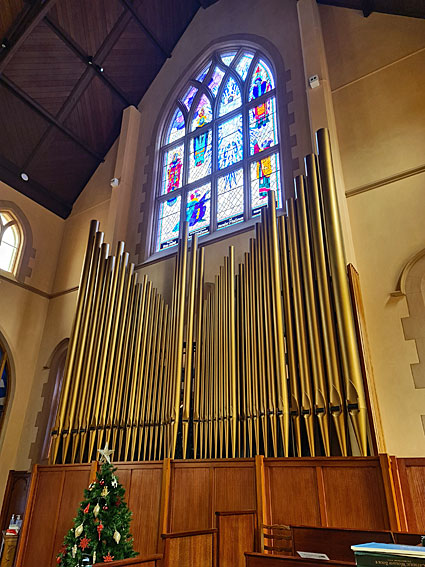
St Peter’s Catholic Church, Toorak: organ
[photograph by Daniel Bittner (December 2020)]
In 1973 the organ was moved to St Peter’s Catholic Church, Toorak and placed within an apsidal baptistery at the rear of the building. The work was funded by Sir Donald Trescowthick. No internal changes were made to the instrument at the time, but new lower case panelling was manufactured and the façade pipes rearranged symmetrically.

St Peter’s Catholic Church, Toorak: console
[photograph by John Maidment (9 February 2021)]
The organ was totally removed from St Peter’s Church by Australian Pipe Organs Pty Ltd in 2019 at the time the interior of the church was being refurbished. The following work took place to the organ:
• Manufacture of a new detached console incorporating the 1965 Fincham ivory keyboards and stopkeys.
• Manufacture of a new Great slider windchest of smaller dimensions than the previous one (that included a number of unfilled slides).
• Manufacture of a new wind system.
• Installation of electro-mechanical slider motors.
• Installation of four new reed ranks and an Open Diapason no 2 to the Great and a Voix Celeste to the Swell (moved from elsewhere in the organ).
• Installation of new transmission and combination systems.
• Reduction in the depth of the organ and some internal replanning.
• The whole organ has been carefully revoiced and rebalanced.
The organ was reinstalled in the church late in 2020. In a very lively acoustic, the overall sound is powerful, brilliant and projects admirably.22
| GREAT Double Open Diapason Open Diapason no 1 Open Diapason no 2 Stop’d Diapason Principal Harmonic Flute Twelfth Fifteenth Mixture 19.22.26 Trumpet Festival Trumpet Swell to great Sub Swell to Great Swell to Great Super Choir to Great Sub Choir to Great Choir to Great Super |
16 8 8 8 4 4 2-2/3 2 III 8 8 |
A previously on Pedal Organ 1965 Pedal Harmonic Tromba completed B new 2020 |
|
| SWELL Open Diapason Gedeckt Viola da Gamba Voix Celeste Principal Flauto Traverso Twelfth Fifteenth Mixture Double Trumpet Cornopean Oboe Sub Octave Super Octave Tremulant |
8 8 8 8 4 4 2-2/3 2 III 16 8 8 |
TC previous string rank inserted here new 2020 new 2020 |
|
| CHOIR Stop’d Flute Dulciana Principal Flute Nazard Piccolo Tierce Clarinet Tremulant Festival Trumpet Clarion Sub Octave Super Octave Swell to Choir Sub Swell to Choir Swell to Choir Super |
8 8 4 4 2-2/3 2 1-35 8 8 4 |
(unenclosed) previously on Great Organ B new 2020 B new 2020 |
|
| PEDAL Acoustic Bass Open Diapason Wood Open Diapason Metal Bourdon Octave Principal Bass Flute Octave Quint Fifteenth Octave Flute Mixture Trombone Trumpet Great to Pedal Swell to Pedal Choir to Pedal |
32 16 16 16 8 8 8 5-1/3 4 4 3 rks 16 8 |
C A D C A D D A D A B new 2020 B new 2020 |
Compass: 61/3223
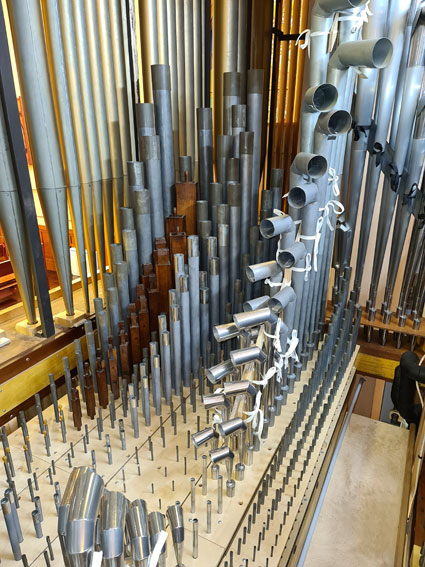
St
Peter’s Catholic Church, Toorak: Great pipework
[photograph by Daniel Bittner (December 2020)]
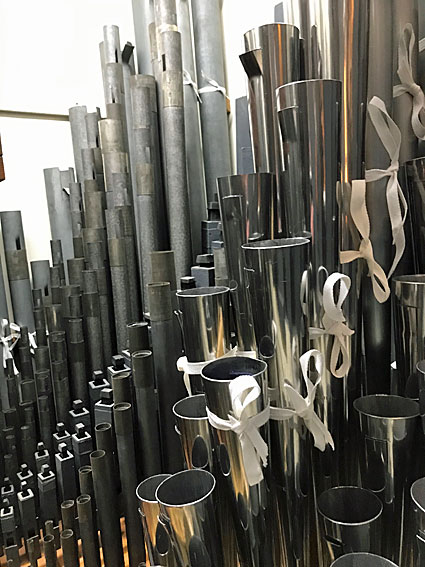
St Peter’s Catholic Church, Toorak: Swell pipework
[photograph by John Maidment (9 February 2021)]
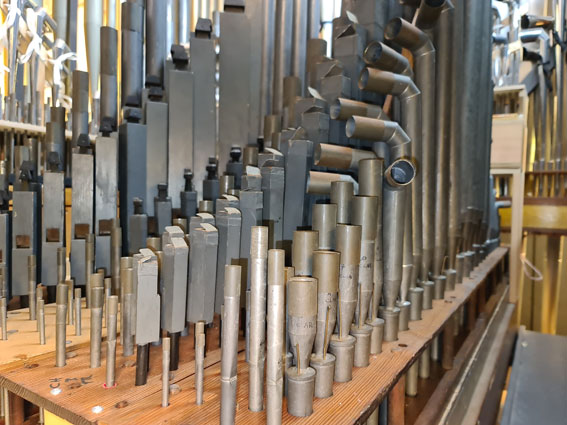
St Peter’s Catholic Church, Toorak: choir pipework showing the hooded Clarinet (Cremona)
[photograph by Daniel Bittner (December 2020)]
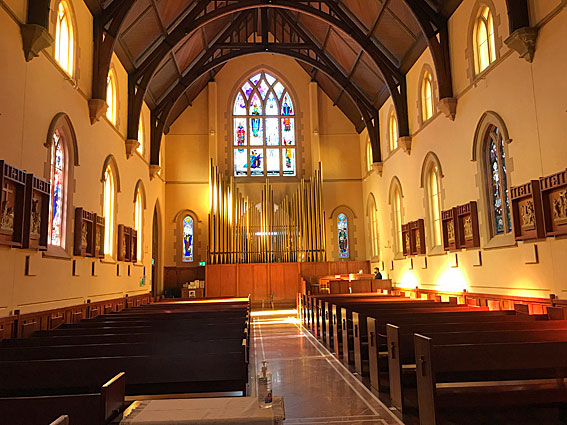
St Peter’s Catholic Church, Toorak: organ viewed from the sanctuary
[photograph by John Maidment (9 February 2021)]
1. The Argus, 12 February 1912, p.9
2. The Herald, 1 November 1933, p.18. Ole Henry Jorgensen (1889-1978) also designed Xavier College Chapel, St Francis Monastery in the City, Holy Cross, South Caulfield and Our Lady of Lourdes, Armadale. He lived at 21 Alma Road, Camberwell – the house is still standing behind a high hedge.
3. Pers. comm. Dr Bronwyn Hughes OAM to John Maidment 10 February 2021. She has written: Mathieson & Gibson installed several windows: four in the sanctuary, Crucifixion, Last Supper, Christ's Charge to Peter and Follow Me; and The Annunciation in the Lady Chapel. Also in the sanctuary is Christ Stilling the Water designed by Martin Pater, St Gerards Studio. Pater was one of the Dutch emigrés post- 1945, and his grandson, Michael is still running a business in Pakenham. Brooks, Robinson & Co: The Deposition, Resurrection (1955). The BR job books records that the Resurrection and Agony in the Garden were ordered, so maybe it was changed for The Deposition. Alan Sumner installed the doors to the porch. Geoff Wallace: two single lights in the west end, St Peter and Solomon(?) 1999.
4. The Invention of Melbourne: A Baroque Archbishop and a Gothic Architect, edited by Jaynie Anderson et al. Carlton: Miegunyah Press, 2019, p.35
5. As in David Rankin, The History of the Music at St. Francis’ Church, 1839-1979, p.26 and John H. Byrne, Echoes of Home: Music at St Francis 1845-1995 (Melbourne: St Francis Choir, 1995), p.43. For the possible original source of this information see reference 20.
6. London Daily News, 12 May 1851, p.2
7. At St Mary’s Cathedral, Sydney and in his home ‘The Grange’, Ramsgate, Kent
8. Henry Smith was the son of Bristol organbuilder John Smith who worked in Melbourne in the first half of the 1850s. John Smith & Sons secured five orders for new organs in Melbourne at the time.
9. Argus, 12 November 1853, p.5; South Australian Register, 21 November 1853, p.3
10. The Age, 15 July 1858, p.5. Jesse Biggs had trained with the English firm of Gray & Davison and built a handful of small organs while resident in Melbourne and Launceston in Tasmania. One survives at Cavendish, Victoria.
11. The Argus, 18 November 1868, p.4
12. The Advocate, 29 November 1873, p.6
13. The Advocate, 7 March 1874, p.5. “Second best in Australia”. Presumably the best was the Melbourne Town Hall organ. There is no evidence to suggest that 14 stops were replaced with Hill & Son pipework. The so-called Geigen Principal was nothing more than a standard Keraulophon. Elsewhere (The Age, 23 April 1873, p.3) it was claimed that the organ after his work would have 44 stops and the cost between £1100 and £1200. The existing St Francis’ organ was to be transferred to SS Peter & Paul’s Church, South Melbourne, which never happened.
14. As observed by Daniel Bittner 2020 while the organ was dismantled
15. E.N. Matthews, “An Organ 112 Years Old”, The Age, 17 July 1965.
16. E.N. Matthews, Colonial Organs and Organbuilders. Carlton: Melbourne University Press, 1969, pp.111-112 from the Fincham records.
17. Note the tap for the hydraulic blowing engine, the Geo. Fincham & Son Melbourne & Sydney nameplate, the swell pedal converted to balanced operation, and the placement of the Swell stops on the right hand sloping stop jamb (owing to the reversal of the console position). The drawstop engraving and keycheeks, together with the oak casing suggest that the console was the work of Mackenzie.
18. The Advocate, 24 July 1909, p.20
19. Specification from the Geo.Fincham & Son letter books held at the State Library of Victoria
20. The Advocate, 8 October 1910, p.19
21. Noted by John Maidment 1965
22. Discussion with Daniel Bittner 9 February 2021
23. Noted by John Maidment 9 February 2021